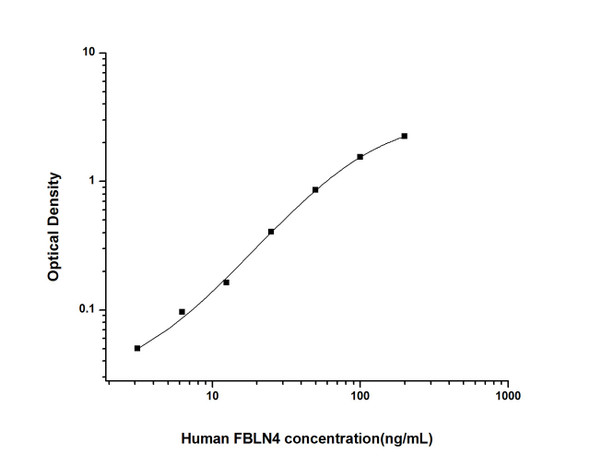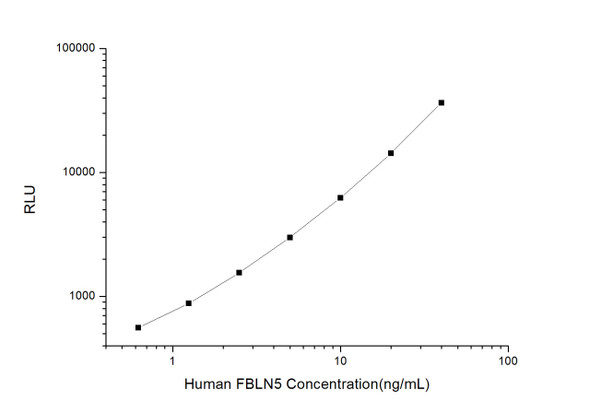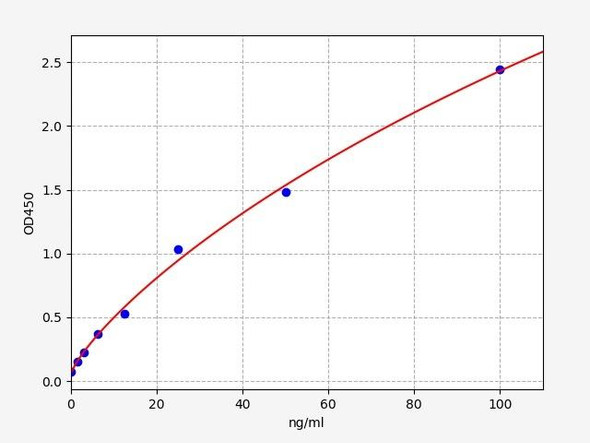Human Cell Biology ELISA Kits 3
Human FBLN4 (Fibulin 4) CLIA Kit (HUES00270)
- SKU:
- HUES00270
- Product Type:
- ELISA Kit
- ELISA Type:
- CLIA Kit
- Size:
- 96 Assays
- Sensitivity:
- 0.38ng/mL
- Range:
- 0.63-40ng/mL
- ELISA Type:
- Sandwich
- Synonyms:
- EFEMP2, ARCL1B, MBP1, UPH1
- Reactivity:
- Human
- Sample Type:
- Serum, plasma and other biological fluids
- Research Area:
- Cell Biology
Description
| Assay type: | Sandwich |
| Format: | 96T |
| Assay time: | 4.5h |
| Reactivity: | Human |
| Detection method: | Chemiluminescence |
| Detection range: | 0.63-40 ng/mL |
| Sensitivity: | 0.38 ng/mL |
| Sample volume: | 100µL |
| Sample type: | Serum, plasma and other biological fluids |
| Repeatability: | CV < 15% |
| Specificity: | This kit recognizes Human FBLN4 in samples. No significant cross-reactivity or interference between Human FBLN4 and analogues was observed. |
This kit uses Sandwich-CLIA as the method. The micro CLIA plate provided in this kit has been pre-coated with an antibody specific to Human FBLN4. Standards or samples are added to the appropriate micro CLIA plate wells and combined with the specific antibody. Then a biotinylated detection antibody specific for Human FBLN4 and Avidin-Horseradish Peroxidase (HRP) conjugate are added to each micro plate well successively and incubated. Free components are washed away. The substrate solution is added to each well. Only those wells that contain Human FBLN4, biotinylated detection antibody and Avidin-HRP conjugate will appear fluorescence. The Relative light unit (RLU) value is measured spectrophotometrically by the Chemiluminescence immunoassay analyzer. The RLU value is positively associated with the concentration of Human FBLN4. The concentration of Human FBLN4 in the samples can be calculated by comparing the RLU of the samples to the standard curve.
| UniProt Protein Function: | EFEMP2: Defects in EFEMP2 are the cause of cutis laxa, autosomal recessive, type 1B (ARCL1B). A connective tissue disorder characterized by characterized by loose, hyperextensible skin with decreased resilience and elasticity leading to a premature aged appearance. Face, hands, feet, joints, and torso may be differentially affected. The clinical spectrum of autosomal recessive cutis laxa is highly heterogeneous with respect to organ involvement and severity. ARCL1B features include emphysema, lethal pulmonary artery occlusion, aortic aneurysm, cardiopulmonary insufficiency, birth fractures, arachnodactyly, and fragility of blood vessels. Belongs to the fibulin family. |
| UniProt Protein Details: | Protein type:Secreted, signal peptide; Secreted Chromosomal Location of Human Ortholog: 11q13. 1 Cellular Component: basement membrane; extracellular region Molecular Function:extracellular matrix structural constituent; protein binding Disease: Cutis Laxa, Autosomal Recessive, Type Ib |
| NCBI Summary: | A large number of extracellular matrix proteins have been found to contain variations of the epidermal growth factor (EGF) domain and have been implicated in functions as diverse as blood coagulation, activation of complement and determination of cell fate during development. The protein encoded by this gene contains four EGF2 domains and six calcium-binding EGF2 domains. This gene is necessary for elastic fiber formation and connective tissue development. Defects in this gene are cause of an autosomal recessive cutis laxa syndrome. Alternatively spliced transcript variants have been identified for this gene. [provided by RefSeq, Jan 2011] |
| UniProt Code: | O95967 |
| NCBI GenInfo Identifier: | 134047775 |
| NCBI Gene ID: | 30008 |
| NCBI Accession: | O95967. 3 |
| UniProt Secondary Accession: | O95967,O75967, A8K7R4, B3KM31, B3KQT1, |
| UniProt Related Accession: | O95967 |
| Molecular Weight: | 49,405 Da |
| NCBI Full Name: | EGF-containing fibulin-like extracellular matrix protein 2 |
| NCBI Synonym Full Names: | EGF containing fibulin like extracellular matrix protein 2 |
| NCBI Official Symbol: | EFEMP2 |
| NCBI Official Synonym Symbols: | MBP1; UPH1; FBLN4; ARCL1B |
| NCBI Protein Information: | EGF-containing fibulin-like extracellular matrix protein 2 |
| UniProt Protein Name: | EGF-containing fibulin-like extracellular matrix protein 2 |
| UniProt Synonym Protein Names: | Fibulin-4; FIBL-4; Protein UPH1 |
| Protein Family: | EGF-containing fibulin-like extracellular matrix protein |
| UniProt Gene Name: | EFEMP2 |
| UniProt Entry Name: | FBLN4_HUMAN |
As the RLU values of the standard curve may vary according to the conditions of the actual assay performance (e. g. operator, pipetting technique, washing technique or temperature effects), the operator should establish a standard curve for each test. Typical standard curve and data is provided below for reference only.
| Concentration (ng/mL) | RLU | Average | Corrected |
| 40 | 33718 39358 | 36538 | 36508 |
| 20 | 13403 15229 | 14316 | 14286 |
| 10 | 6519 6027 | 6273 | 6243 |
| 5 | 2962 3074 | 3018 | 2988 |
| 2.5 | 1591 1573 | 1582 | 1552 |
| 1.25 | 942 882 | 912 | 882 |
| 0.63 | 585 593 | 589 | 559 |
| 0 | 29 31 | 30 | -- |
Precision
Intra-assay Precision (Precision within an assay): 3 samples with low, mid range and high level Human FBLN4 were tested 20 times on one plate, respectively.
Inter-assay Precision (Precision between assays): 3 samples with low, mid range and high level Human FBLN4 were tested on 3 different plates, 20 replicates in each plate.
| Intra-assay Precision | Inter-assay Precision | |||||
| Sample | 1 | 2 | 3 | 1 | 2 | 3 |
| n | 20 | 20 | 20 | 20 | 20 | 20 |
| Mean (ng/mL) | 1.85 | 5.34 | 16.51 | 2.03 | 5.72 | 16.91 |
| Standard deviation | 0.19 | 0.62 | 1.45 | 0.24 | 0.47 | 1.94 |
| C V (%) | 10.27 | 11.61 | 8.78 | 11.82 | 8.22 | 11.47 |
Recovery
The recovery of Human FBLN4 spiked at three different levels in samples throughout the range of the assay was evaluated in various matrices.
| Sample Type | Range (%) | Average Recovery (%) |
| Serum (n=5) | 91-104 | 98 |
| EDTA plasma (n=5) | 88-100 | 94 |
| Cell culture media (n=5) | 90-103 | 97 |
Linearity
Samples were spiked with high concentrations of Human FBLN4 and diluted with Reference Standard & Sample Diluent to produce samples with values within the range of the assay.
| Serum (n=5) | EDTA plasma (n=5) | Cell culture media (n=5) | ||
| 1:2 | Range (%) | 93-109 | 99-114 | 99-111 |
| Average (%) | 101 | 107 | 105 | |
| 1:4 | Range (%) | 98-113 | 88-101 | 97-109 |
| Average (%) | 105 | 93 | 103 | |
| 1:8 | Range (%) | 98-111 | 96-113 | 96-109 |
| Average (%) | 105 | 103 | 103 | |
| 1:16 | Range (%) | 86-97 | 88-100 | 97-112 |
| Average (%) | 91 | 95 | 105 |
An unopened kit can be stored at 4°C for 1 month. If the kit is not used within 1 month, store the items separately according to the following conditions once the kit is received.
| Item | Specifications | Storage |
| Micro CLIA Plate(Dismountable) | 8 wells ×12 strips | -20°C, 6 months |
| Reference Standard | 2 vials | |
| Concentrated Biotinylated Detection Ab (100×) | 1 vial, 120 µL | |
| Concentrated HRP Conjugate (100×) | 1 vial, 120 µL | -20°C(shading light), 6 months |
| Reference Standard & Sample Diluent | 1 vial, 20 mL | 4°C, 6 months |
| Biotinylated Detection Ab Diluent | 1 vial, 14 mL | |
| HRP Conjugate Diluent | 1 vial, 14 mL | |
| Concentrated Wash Buffer (25×) | 1 vial, 30 mL | |
| Substrate Reagent A | 1 vial, 5 mL | 4°C (shading light) |
| Substrate Reagent B | 1 vial, 5 mL | 4°C (shading light) |
| Plate Sealer | 5 pieces | |
| Product Description | 1 copy | |
| Certificate of Analysis | 1 copy |
- Set standard, test sample and control (zero) wells on the pre-coated plate and record theirpositions. It is recommended to measure each standard and sample in duplicate. Note: addall solutions to the bottom of the plate wells while avoiding contact with the well walls. Ensuresolutions do not foam when adding to the wells.
- Aliquot 100µl of standard solutions into the standard wells.
- Add 100µl of Sample / Standard dilution buffer into the control (zero) well.
- Add 100µl of properly diluted sample (serum, plasma, tissue homogenates and otherbiological fluids. ) into test sample wells.
- Cover the plate with the sealer provided in the kit and incubate for 90 min at 37°C.
- Aspirate the liquid from each well, do not wash. Immediately add 100µL of BiotinylatedDetection Ab working solution to each well. Cover the plate with a plate seal and gently mix. Incubate for 1 hour at 37°C.
- Aspirate or decant the solution from the plate and add 350µL of wash buffer to each welland incubate for 1-2 minutes at room temperature. Aspirate the solution from each well andclap the plate on absorbent filter paper to dry. Repeat this process 3 times. Note: a microplatewasher can be used in this step and other wash steps.
- Add 100µL of HRP Conjugate working solution to each well. Cover with a plate seal andincubate for 30 min at 37°C.
- Aspirate or decant the solution from each well. Repeat the wash process for five times asconducted in step 7.
- Add 100µL of Substrate mixture solution to each well. Cover with a new plate seal andincubate for no more than 5 min at 37°C. Protect the plate from light.
- Determine the RLU value of each well immediately.






